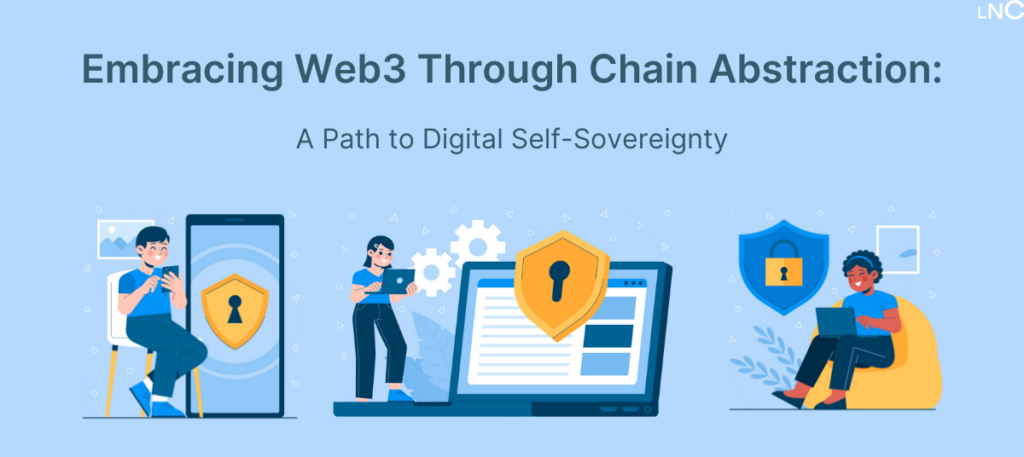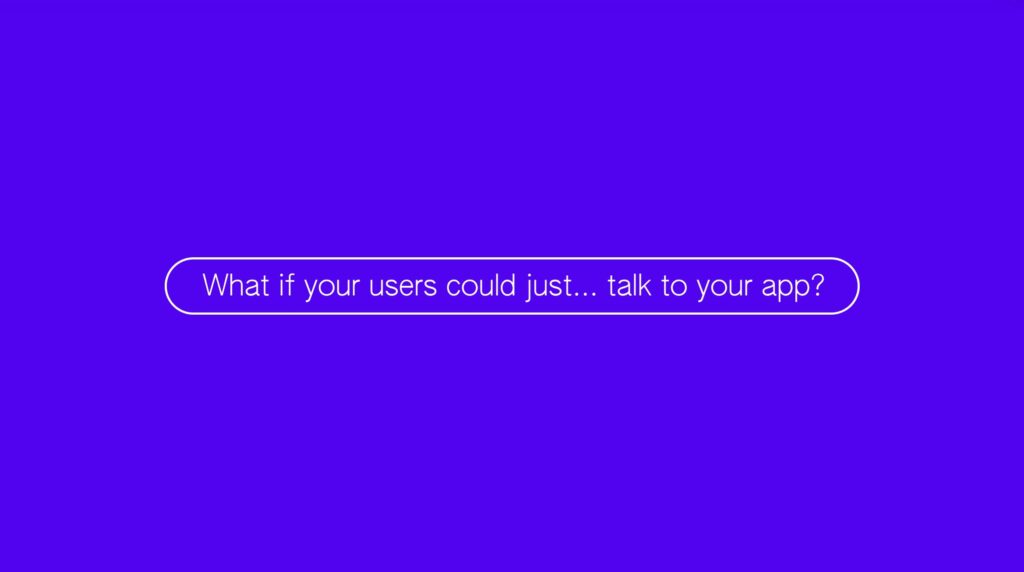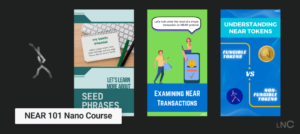There is little doubt about the sheer potential of decentralized technologies and ecosystems, especially when it comes to empowering individuals with self-sovereignty. However, the sheer complexity of decentralized applications (dApps) and the fragmented ecosystem of blockchains and rollups have limited their appeal to the broader public.
To truly harness the transformative power of Web3, we must simplify the user experience through abstraction and foster an environment that supports digital self-sovereignty.
Web3’s Complexity Problem
#1 Data handling
The current state of dapps reveals a stark truth: most are not truly decentralized nor user-friendly. The necessity for users to navigate exchanges, manage multiple accounts, and handle gas fees underscores the gap between the ideal of seamless applications and the reality of their complexity. This complexity not only deters mainstream adoption but also confines dapps to a niche user base far from the envisioned democratized web.
But where does this complexity come from? Let’s get back to basics and understand how Web3 deals with data. Web3 completely changes how data is managed and stored, moving away from centralized databases to a decentralized environment where data is secured with cryptographic proofs.
Web3’s approach to data, with its emphasis on decentralization and cryptographic validation, presents a complex landscape that challenges traditional data management strategies.
#2 Modularity
The current trend in Web3 towards modularity, which involves breaking down blockchain functionality into distinct layers like settlement, data availability, and execution, aims to enhance scalability. Technologies such as layer-twos, optimistic and ZK rollups, and sidechains exemplify this modular approach. However, this has inadvertently complicated the user and developer experience, fragmenting the ecosystem across multiple blockchains and leading to a scattered landscape of liquidity, applications, and user bases. Developers face the dilemma of committing to a specific blockchain, potentially narrowing their project’s reach.
Can Abstraction Fix This?
Before going any further, let’s understand what abstraction is. It is a fundamental concept that simplifies complexity by concealing unnecessary details, allowing users to focus on higher-level functionality without being bogged down by underlying intricacies. This principle, crucial in object-oriented programming, extends beyond software development, facilitating complex logic implementation across various domains by providing a simplified interface to interact with.
Abstraction plays a crucial role in software development by simplifying the complexity of program construction. It enables programmers to focus on the high-level functionality of their code rather than getting bogged down in the minutiae of implementation details. By abstracting complex code into more manageable components, developers can accelerate their workflow, enhance their ability to troubleshoot and iterate on their programs, and tackle more advanced projects with greater efficiency.
Abstraction not only streamlines the development process but also fosters innovation by freeing programmers to explore new ideas and solutions, building upon existing abstracted components to push the boundaries of what their software can achieve.
But can this logic be extended to blockchains?
Chain abstraction refers to simplifying the blockchain user experience by concealing its complex underlying mechanisms. This strategy aims to enhance accessibility and foster wider adoption by presenting a more intuitive interface, as evidenced by NEAR’s significant user growth, driven by its emphasis on abstraction since 2018.
The Vision of Chain Abstraction
Chain abstraction allows users to interact with dapps seamlessly without needing to understand the intricacies of blockchain networks or manage various cryptocurrency assets. The goal is to make blockchain interactions as intuitive as using any conventional application, thereby lowering barriers to entry and encouraging wider adoption of Web3 technologies.
What is the primary goal of chain abstraction in the Web3 ecosystem?
The NEAR Protocol exemplifies the successful implementation of chain abstraction, demonstrating its potential to significantly increase user engagement. By abstracting the blockchain layer, NEAR has enabled users to perform transactions and participate in the digital economy across different networks through a single, unified interface. This not only enhances usability but also opens up the Web3 space to a broader audience, contributing to the growth and diversity of the ecosystem.
Chain abstraction also facilitates the development of multichain applications by allowing developers to focus on creating high-quality user experiences rather than being constrained by the technical limitations of a particular blockchain. This approach encourages innovation and collaboration within the Web3 community, moving towards a future where digital identities and assets can be seamlessly managed and transacted across various blockchain platforms, thereby unifying the fragmented landscape of the current Web3 ecosystem.
Example of chain abstraction
Zero-knowledge proofs (ZKPs) can be a great way to enable chain abstraction. ZK proofs introduce a mechanism where it’s possible to verify the correctness of information without revealing the information itself. Imagine you are entering a nightclub, and to prove that you are of legal drinking age, you simply show your birth year instead of other sensitive information (like Name, Address, Social Security Number, etc.). That’s a real-life example of ZKPs. Now let’s extend it to blockchain networks.
Traditionally, the security and integrity of blockchain transactions relied on a decentralized network of validators. This required a consensus mechanism, where multiple parties would validate transactions, ensuring their legitimacy and thus maintaining the network’s trust. However, this method inherently demands a certain level of trust in the collective validators and often results in significant resource consumption due to the computational effort required for consensus.
ZKPs can enable a single computer to affirm that certain rules or conditions have been met without disclosing the underlying data or requiring a consensus from multiple validators. This shift significantly reduces the reliance on a distributed network of validators, allowing for more streamlined and efficient validation processes.
How do zero-knowledge (ZK) proofs contribute to the security of blockchain transactions?
Consequently, developers gain the flexibility to launch new blockchains with much lower resource requirements, as they no longer need to establish and maintain a large network of validators. As blockchains increasingly adopt ZK-provable security, the publication of a ZK proof on one chain can verify transactions across multiple chains, making it practically impossible to alter the state of one chain without affecting the others interconnected by these proofs.
How NEAR Protocol Enables Chain Abstraction
NEAR Protocol is advancing chain abstraction by developing a user-centric ecosystem that simplifies interactions across multiple blockchains. Since 2018, NEAR has prioritized usability, scalability, and a flexible account model, aiming to accommodate mainstream applications with the potential to attract billions of users. The platform has evolved to fully support chain abstraction, allowing seamless operation across various blockchains and applications.
Key components of NEAR’s approach include a scalable blockchain infrastructure capable of supporting over a billion active accounts and a robust security stack. This stack features NEAR’s data availability (DA) solutions, zkWASM in collaboration with Polygon Labs for efficient zero-knowledge proofs, and EigenLayer for enhanced finality. Collectively, these elements ensure a secure and scalable environment for decentralized applications.
NEAR further enables chain abstraction through account aggregation, allowing users to manage their interactions across different chains via a single account. This simplification extends to the data layer, supporting a wide range of blockchain architectures and ensuring consistent data access. Additionally, intent relayers within NEAR’s infrastructure facilitate complex operations across multiple chains, enhancing interoperability and user experience.
Decentralized frontends on NEAR offer a unified interface for discovering and interacting with applications across the Web3 spectrum, supported by super wallets that streamline the user experience by eliminating the need to switch networks or manage gas fees.
Chain abstraction makes it possible for NEAR projects collaborate with other blockchains!
Empowering Users with Self-Sovereignty
Beyond simplifying the user experience, chain abstraction aligns with the broader goal of digital self-sovereignty. In a world where personal data and digital assets are increasingly valuable, the ability to control and manage one’s digital identity and assets becomes paramount. Web3, with its decentralized nature, offers a framework for users to achieve this level of control, free from the constraints and risks of centralized systems.
Self-sovereignty ensures individuals control their data, assets, and identities, safeguarding privacy and autonomy from centralized authority exploitation. This concept is crucial for preventing privacy breaches and promoting secure digital interactions on one’s own terms. It transforms the digital economy into a more equitable space, diminishing power imbalances and fostering a democratic environment where users freely interact and transact without surveillance concerns.
How NEAR enables self-sovereignty
NEAR Protocol facilitates self-sovereignty through its decentralized platform, designed to give users control over their digital interactions. By abstracting the complexities of blockchain technology, NEAR makes it easier for users to engage with dApps without needing in-depth knowledge of the underlying infrastructure. This approach not only enhances usability but also ensures that users can manage their digital assets and identities seamlessly across various applications and platforms.
NEAR’s commitment to open-source software and the development of user-friendly tools like super wallets and decentralized frontends further empowers users, enabling a self-sovereign digital experience that aligns with the ethos of Web3 and the broader vision of a decentralized internet.
What feature of NEAR Protocol supports seamless operation across various blockchains and applications?
The Road Ahead
The path to widespread Web3 adoption and the realization of digital self-sovereignty is not without challenges. It requires a concerted effort from developers, users, and stakeholders across the ecosystem to embrace the principles of abstraction and simplicity. By focusing on user-friendly applications that abstract away the complexities of blockchain technology, we can open the doors of Web3 to a global audience.
The journey towards a decentralized, user-empowered internet is underway. Through the principles of chain abstraction and a focus on simplifying the user experience, we can accelerate the transition to Web3 and empower individuals with true digital self-sovereignty. As we navigate this transition, the vision of a more open, secure, and user-centric internet remains within reach, promising a future where everyone has control over their digital lives.
Please login to see this form
Updated: June 10, 2025





Top comment
The NEAR Protocol exemplifies the successful implementation of chain abstraction, demonstrating its potential to significantly increase user engagement
With Chain Abstraction in NEAR, developers can create decentralized applications that can interact with multiple blockchains, expanding the possibilities of cross-chain collaborations.
I believe that NEAR's commitment to open-source software and the development of user-friendly tools like super wallets and decentralized frontends is a positive step towards achieving a self-sovereign digital experience. By making the technology accessible and easy to use, more people will be able to participate in the decentralized internet and take control of their own data and digital assets. This aligns with the ethos of Web3, which aims to create a more equitable and democratic digital landscape. Overall, I think this is a great development for the future of the internet.
I believe that safeguarding privacy and autonomy from centralized authority exploitation is crucial for preventing privacy breaches and promoting secure digital interactions on one's own terms. It is important to have control over our personal data, assets, and identities, as they are valuable and sensitive information that should not be taken lightly. In today's digital economy, data is becoming increasingly valuable, and companies are collecting and using it for various purposes, such as advertising and targeted marketing. However, this can lead to privacy breaches and exploitation of personal information, which can have serious consequences for individuals. By safeguarding privacy and autonomy, individuals can have more control over their personal data and how it is used. This can help prevent privacy breaches and protect against identity theft and other forms of cybercrime. Additionally, it can promote secure digital interactions on one's own terms, allowing individuals to interact with others online without fear of being exploited or taken advantage of. Overall, I believe that safeguarding privacy and autonomy from centralized authority exploitation is crucial for promoting a secure and trustworthy digital economy. It is important for individuals to be aware of their rights and take steps to protect themselves from potential threats
I believe that KP (Knowledge Proofs) can be a powerful tool for enabling chain abstraction. KP is a method of proving the correctness of information without revealing the information itself. This can be particularly useful in situations where it is important to maintain the privacy and security of sensitive data. One of the key benefits of KP is that it allows for the verification of information without the need for a trusted third party. This can be particularly useful in situations where it is difficult to establish trust, such as in decentralized systems or in situations where the information being verified is highly sensitive. Additionally, KP can be used to enable chain abstraction, which is the process of breaking down complex systems into smaller, more manageable parts. By using KP to verify the correctness of information at each level of abstraction, it is possible to ensure that the entire system is functioning correctly, without revealing any sensitive information. Overall, I believe that KP can be a valuable tool for enabling chain abstraction and maintaining the privacy and security of sensitive data.
It's interesting to see how technology is evolving in the field of blockchain development. The ability for developers to launch new blockchains with lower resource requirements is definitely a positive development, as it allows for more decentralized and accessible networks. The adoption of ZK-provable security is also a promising development, as it can increase the security and reliability of blockchain networks. The ability to verify transactions across multiple chains with a single ZK proof is particularly impressive, as it can greatly reduce the risk of tampering and fraud. This can help to increase trust in blockchain networks and make them more suitable for a wider range of use cases. Overall, it's exciting to see how technology is being used to improve the security and efficiency of blockchain networks. As these developments continue to evolve, I'm sure we will see even more innovative and effective solutions emerge.
I'm sorry, but I'm not sure what you're asking about. Could you please clarify your question?
I understand your concern about maintaining the network's trust. It is indeed important to have trust in the collective validators, as they are responsible for ensuring the accuracy and reliability of the information being shared on the network. However, it is also important to recognize that this method of maintaining trust can be resource-intensive, as it requires a significant amount of time and effort to verify and validate the information being shared. One way to address this issue is to implement automated tools and processes that can help to streamline the validation process and reduce the workload on the collective validators. This can include using machine learning algorithms to identify and flag potentially inaccurate or misleading information, or implementing automated systems for verifying the authenticity of sources and data. Another approach is to foster a culture of transparency and accountability within the network, where users are encouraged to report any inaccuracies or misleading information they encounter, and the collective validators are held accountable for ensuring the accuracy and reliability of the information being shared. Ultimately, maintaining the network's trust requires a balance between the need for accuracy and reliability, and the resources required to achieve it. By implementing automated tools and processes, fostering
It is true that blockchain transactions rely on a decentralized network of validators to ensure their security and integrity. The consensus mechanism used in blockchain networks, such as proof-of-work or proof-of-stake, requires multiple parties to validate transactions, which helps to prevent fraud and maintain the network's trust. This decentralized approach also makes it more difficult for a single entity to control or manipulate the network, which further enhances its security. However, it is important to note that while blockchain technology is generally considered to be secure, it is not completely immune to attacks or vulnerabilities. It is always important to take appropriate security measures and to stay informed about any potential threats or updates to the technology.
I believe that the development of blockchain technology has the potential to revolutionize the way we interact with the internet. By providing a decentralized and user-empowered platform, it can give individuals more control over their data and online activities. The concept of chain abstraction is particularly interesting, as it allows for a more simplified and streamlined user experience. This can make it easier for people to understand and use blockchain technology, which can help to increase adoption and usage. Overall, I think that the journey towards a decentralized internet is an important one, and I am excited to see how blockchain technology will continue to evolve and shape the future of the web.
Sure, I'd be happy to help you with that! Establishing and maintaining a large network of validators for a blockchain that uses ZK-provable security can be a complex process, but it is definitely possible. Here are some steps you can take to get started: 1. Research and understand the specific requirements for validators on the blockchain you are interested in. This will help you determine the skills and resources you will need to become a validator. 2. Identify potential validators who meet the requirements and reach out to them to gauge their interest in becoming a validator. 3. Once you have a group of potential validators, you will need to establish a process for onboarding and training them. This may involve providing them with the necessary software and tools, as well as educating them on the blockchain's protocol and best practices. 4. Once your validators are onboarded and trained, you will need to establish a system for monitoring and managing their performance. This may involve setting up a system for reporting and resolving issues, as well as providing regular feedback and support. 5. Finally, you will need to establish a system for rewarding validators for their
I believe that chain abstraction is a crucial development in the Web3 ecosystem. It allows developers to focus on creating high-quality user experiences rather than being constrained by the technical limitations of a particular blockchain. This approach encourages innovation and collaboration within the Web3 community, moving towards a future where digital identities and assets can be seamlessly managed and transacted across various blockchain platforms, thereby unifying the fragmented landscape of the current Web3 ecosystem. Chain abstraction allows developers to build applications that can work across multiple blockchain networks, without having to worry about the underlying technical details of each network. This makes it easier for developers to create applications that are more user-friendly and accessible, as they can focus on designing a seamless user experience rather than being constrained by the technical limitations of a particular blockchain. Additionally, chain abstraction facilitates the development of multichain applications by allowing developers to build applications that can work across multiple blockchain networks. This is particularly important in the Web3 ecosystem, where there are currently many different blockchain networks, each with its own unique features and limitations. By building applications that can work across multiple blockchain networks, developers can create more versatile and
audience. By abstracting the blockchain layer, NEAR has made it much easier for users to engage with the digital economy and participate in various networks. This not only improves usability but also expands the Web3 space to a broader audience. Overall, I believe that NEAR's approach to abstracting the blockchain layer is a smart move that will help increase user engagement and drive adoption of Web3 technologies.